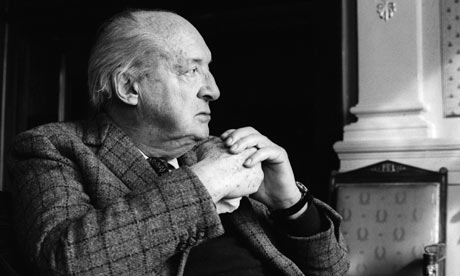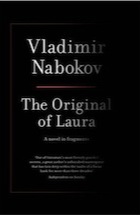
Vladimir Nabokov in 1975. Photograph: Sophie Bassouls/Sygma/Corbis
By now, most serious readers will have some idea of the story behind the publication of The Original of Laura, and most everyone will also have an opinion about whether it should have been published – from the most cynical (they did it for money) to the overly generous (it is a work of incomparable genius). Mine, as a huge Vladimir Nabokov fan and the editor at Penguin Classics who looked after the book, is the result of almost 18 months of wondering in isolation. As the reviews have begun to pour in, it's fascinating, and sometimes alarming, to see what others have thought. Some have pieces been thoughtful and careful (particularly Martin Amis's
- The Original of Laura: (Dying is Fun) a Novel in Fragments (Penguin Modern Classics)
- by Vladimir Nabokov
- 304pp,
- Penguin Classics,
- £20.00

in The Guardian, Sam Anderson's in New York Magazine, and Michiko Kakutani's in The New York Times); others have been more dismissive of the work, treating it as a completed novel, when it's not.
I can tell you that Nabokov's son Dmitri did not publish this book against Vladimir's wishes because he wanted money for a sportscar. Dmitri is 76, and in a wheelchair. This was a question, among other things, of legacy and of keeping the decision in the family.
There is no doubt that the circumstances of publication and the media storm surrounding it has provoked a hostile backlash from some, but I hope others will read the text as carefully as they discuss the moral implications of publishing it at all. Decide for yourself.
The visual pleasure of reading The Original of Laura is as integral to the experience as the words. Chip Kidd, the designer, wanted to bring readers as close as possible to the experience of reading the cards as Nabokov wrote them, and to relay as honestly as possible the fact that Laura is not a finished novel. The result is one of the most beautiful books I've ever seen: 138 perforated photographs of the original cards reproduced on thick cardboard paper to the highest possible quality. To be sure, the pleasures of reading The Original of Laura are not those of a finished novel, but the intimacy of reading the cards in this way offers readers an insight into the man and the writer that they will never have had before. Personally, I find the experience of reading them poignant and melancholy; a rare glimpse into the creative practices of a deeply private and evasive man: the smudges and fingerprints on the cards, the food stains, the imperfect sentences of a perfect stylist, the erasures, misspellings, second thoughts, misgivings, and the loopy and elegant, almost child-like handwriting.
I don't believe, as Amis would have it, that the cards allow us to bear uncomfortable witness to the death of genius, and that this private fact should never have been made public knowledge. Martin Amis suggests that in reading Laura he has witnessed the fall of his idol (in truth, Amis has never rated late Nabokov, finished or unfinished). Laura was complete in Nabokov's mind, if not on paper, and he told his son Dmitri that he considered it one of his three most important works. The sad fact of Laura isn't what it reveals of its author's decline but rather, given its immense promise, that it was left unfinished.
We see, too, that this exquisite stylist had to work, to draft and craft his sentences; they didn't land fully-formed on the page. They began imperfectly, we see, but became some of the most playful, beautiful, exotic and cadent sentences of the 20th century. Nabokov, it turns out, was a grafter, and I am glad to know it first-hand, for what it says about the making of art and the difficulty of writing, and about the gift Nabokov gave his readers. And I think Dmitri has also given us a gift: he has acknowledged, in his way, that Nabokov's work no longer only belongs to the family, but to our culture. He ignored the wishes of his father, to fulfil the public's desire to know Nabokov whole, and in doing so admitted something profoundly difficult for him: that an artist's gift and his art do not belong to the artist, nor to his family, but to us all.
From a moral standpoint, it certainly could be argued that it was wrong to publish Laura, but as a fan, from a slightly abashed selfish standpoint, I am grateful that Nabokov was overruled. And from a publisher's perspective, I am grateful to have the public's roving spotlight shine momentarily on this remarkable and under-read genius. For though Nabokov is one of the most highly regarded modern authors, that enthusiasm has not translated, with the exception of Lolita, into his books actually being read. How is it that one of the greatest, most seductive and most delightfully humorous of all 20th-century writers is so neglected? It's partly, I think, due to the public's tired association of Nabokov with butterflies and little girls. In other words, the notoriety of Lolita has blinded the public to Nabokov's other books and to the extraordinary range of his subjects and styles.
In Penguin's relaunch of Nabokov, we've tried to change that. Nabokov is, unquestionably, as Edmund White once described him, "the high priest of desire", one of the greatest writers on the erotic ever to have lived. But Nabokov is also better at noir than Raymond Chandler, and wrote about the giddiness of despair, the revelations of art, the twinning of mortality and immortality, the melancholy of memory, the fractures in the self, and the mysteries of happiness, kindness, humour, love. His preocuppations included identity and the double; chess masters, hapless college professors, young men striving to fulfil their artistic vocation, and rebels against tyranny. Nearly all of Nabokov's books, not least Lolita, are passionately empathetic portraits of the victims of cruelty. The style for which he is best known is the ardency of Lolita, but this is only one pole of his prose. Nabokov is in fact most remarkable for the sheer range of his styles: he never wrote the same way twice. His writing veers from the facetious pastiches of romance fiction in Ada to the mercilessly dry-eyed definitions of grief in such short stories as Signs and Symbols.
To underline the variety and breadth of Nabokov's work, Penguin Classics has reset, redesigned and is re-releasing all of Nabokov's works in themed batches over the next two years. The theme of the first tranche, published today, is transcendent love, childhood, and nostalgia and is meant to introduce the public to a lightness and tenderness not usually associated with Nabokov. It encompasses the rich nostalgia of Speak, Memory, the fond evocations of young love and young artistic ambition in Mary and The Gift, and the intimate sensations of a child's world in The Luzhin Defence.
Nabokov is not known as a satirical writer, but satire is one of his great talents. The second batch, published in April 2010, will include The Collected Stories, Pnin, Laughter in the Dark, Despair, Invitation to a Beheading, Bend Sinister, The Eye, King, Queen Knave, and, finally, Lolita, which while always conceived of as shocking is rarely seen as a satire, though it very much is a hilarious satire of Humbert Humbert, the pompous artist, charming sex fiend and talented serial fantasist. This themed clutch of titles, with its nuanced portrayal of malevolent totalitarianism, was born partly of Nabokov's own flight from tyranny.
The last batch of titles, published in March 2011, will contain the more experimental novels, innovative in form as well as content: Pale Fire, Ada, The Real Life of Sebastian Knight, Transparent Things, Look at the Harlequins!, and a work of non-fiction, Strong Opinions. Nabokov's formal experimentation is unparalleled in world literature. Pale Fire may be the most intricate and aesthetically rewarding literary puzzle ever devised.
Our challenge, in republishing Nabokov's backlist in conjunction with The Original of Laura, as well as the forthcoming new editions of his Collected Poems and Letters to Vera, has been to take advantage of this moment to get the public reading Nabokov more widely. A writer of Nabokov's calibre should not be read partially. Nabokov is of course a great writer, but he also has the potential to be a great popular writer. He is, in the end, first and foremost, a damn good read.